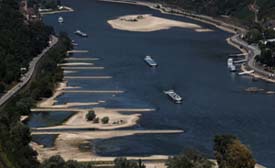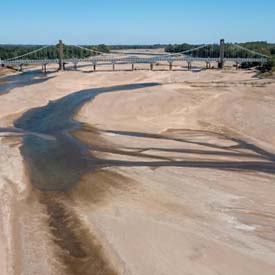Rivers around the world are drying up. Some perennial rivers will eventually dry up permanently—many within this century—because the glaciers that feed them are disappearing at a rapid rate. This could be the plot line of a science fiction movie but this is science fact. Aside from the scientists, meteorologists, and environmentalists, too many people remain clueless about the Earth’s impending ecological crisis. One of the main reasons for this ignorance is the anti-science Luddism promoted by a gaggle of right-wing climate change deniers, medical quacks, junk scientists, lawyers, lobbyists, and politicians who have no business weighing in on subjects about which they have no ability or desire to understand.
The most immediate concern for the United States is the Colorado River, which provides water, hydro-electricity, and irrigation for 40 million people in the American southwest, including the cities of Phoenix and Las Vegas. Also running dry is the Rio Grande, which provides water for New Mexico, Texas, and Mexico. This summer, the river ran dry in Albuquerque.
In Asia, the Indus, which provides water, hydro-power, and irrigation for millions of people in India and Pakistan, has seen its water level decrease by half. Competition for water between two nuclear powers, India and Pakistan, threatens to erupt in military conflict over diminishing water resources.
Also on the subcontinent, the Teesta River, which originates with the Zemu glacier in Sikkim, is drying up because the glacier is rapidly melting. The Teesta provides what can be called SWIE—sustenance water, irrigation, and electricity—to populated regions of India and Bangladesh. The loss of the Indus and Teesta will result in a massive refugee crisis, the likes of which the world has never seen.
 Human-induced climate change has resulted in some of the world’s most iconic rivers drying up. The Blue Danube is now the muddy Danube. The river has dried up so much that recently, a few naval vessels scuttled by the Nazis before their retreat, emerged on the muddy flats left by the ebbing water flow. The Rhine [upper left] is now impassable for river traffic, including barges critical for German manufacturing plants. The situation is the
Human-induced climate change has resulted in some of the world’s most iconic rivers drying up. The Blue Danube is now the muddy Danube. The river has dried up so much that recently, a few naval vessels scuttled by the Nazis before their retreat, emerged on the muddy flats left by the ebbing water flow. The Rhine [upper left] is now impassable for river traffic, including barges critical for German manufacturing plants. The situation is the  same for the Po, Loire [right], Thames, Tagus, Oder, Doubs, Le Toleure, Nile, Mekong, Yongding, Tigris, Euphrates, Salween, Brantas, Qom, Herat, La Plata, and Ganges. In France, the Galardi and Tille Rivers have completely gone dry.
same for the Po, Loire [right], Thames, Tagus, Oder, Doubs, Le Toleure, Nile, Mekong, Yongding, Tigris, Euphrates, Salween, Brantas, Qom, Herat, La Plata, and Ganges. In France, the Galardi and Tille Rivers have completely gone dry.
In the United States, the Arkansas, South Canadian, North Fork Red, and Red River of the South are at their lowest levels, threatening Midwest agriculture, water transportation, and the populations of Arkansas, Kansas, Oklahoma, Colorado, New Mexico, Texas, Louisiana, and the tribal lands of the Chickasaw and Choctaw. Oklahoma City, Little Rock, Wichita Falls, and Shreveport are all directly impacted by their shrinking rivers. The Missouri River is at its driest level in 1200 years. That threatens Kansas City, Sioux City, Jefferson City, Great Falls, Council Bluffs and dozens of other cities that lie on its banks.
Add to America’s endangered rivers the Gasconade in Missouri, Sacramento in California, Ouachita in Louisiana and Arkansas, Smoky Hill in Colorado and Kansas, Big Sunflower in Mississippi, Washita in Texas and Oklahoma, Brazos in Texas and New Mexico, John Day in Oregon, and Pecos in Texas and New Mexico.
The Murray River in Australia, critical to farmers, wildlife, and residential areas actually ran dry in 2007. It is on the verge of doing so again. The Amu Darya River, which originates in the glaciers of the Pamir Mountains in Tajikistan and the Tian Shan range in China and Kazakhstan, is also reaching dangerously low levels. The river empties into the Aral Sea, a body of water that had largely dried up due to aggressive irrigation by the Soviet Union and now by melting glaciers. The Yellow River of Huang He, upon which millions of Chinese depend, is also in extremis due to climate change, over-irrigation, and glacier loss in the Tibetan Plateau. It is the same story for the Yangtze.
Lakes and reservoirs are not fairing much better. Lake Garda in Italy is at its lowest level in recorded history and that goes back to the time of the Roman Empire. Lake Mead, which is fed by the Colorado, is so low that human remains have emerged. Undoubtedly, the victims had run afoul of Las Vegas gangsters. The situation is the same for Lake Powell in Arizona and Utah, also fed by the Colorado. Other lakes that are drying up at a dangerously fast pace include Lake Poopó in Bolivia, Lake Badwater and Owens, Mono, and Tulare Lakes in California, Lake Walker and Pyramid Lake in Nevada, Salton Sea in California, Lake Chad in central Africa, Great Salt Lake in Utah, Lake Velence in Hungary, Lakes Eyre, Hindmarsh, and Albert in Australia, Lake Urmia in Iran, Qinghai, Lop Nur, Alan Nur, Ebinur, and Poyang Lakes in China, Lakes Chapala and Cuitzeo in Mexico, Lake Amik in Turkey, Hamun Lake in Iran and Afghanistan, Lake Hula in Israel, Lake Faguibine in Mali, and the Dead Sea in Jordan and Israel.
In the popular film “Don’t Look Up,” the government and most people do not believe the warning of two astronomers that a planet-killing comet is heading directly toward the Earth. The star-studded Netflix production was panned by right-wing film critics who bashed it for its unveiled criticism of those from climate and pandemic deniers to Donald Trump and his supporters. In what is not an apocalyptic Hollywood movie, if one now looks upriver, they will discover that it is gone.
Previously published in the Wayne Madsen Report.
Copyright © 2022 WayneMadenReport.com
Wayne Madsen is a Washington, DC-based investigative journalist, author and nationally-distributed columnist. A member of the Society of Professional Journalists (SPJ) and the National Press Club. He is the editor and publisher of the Wayne Madsen Report (subscription required).


